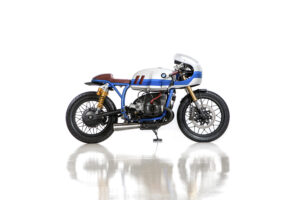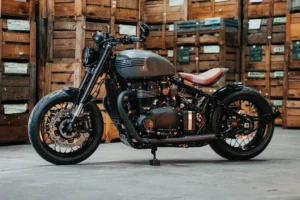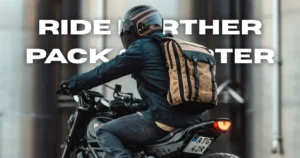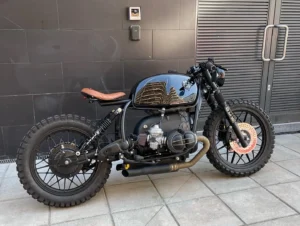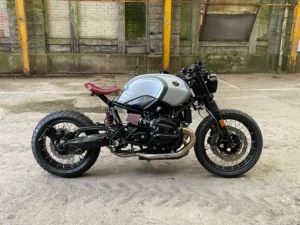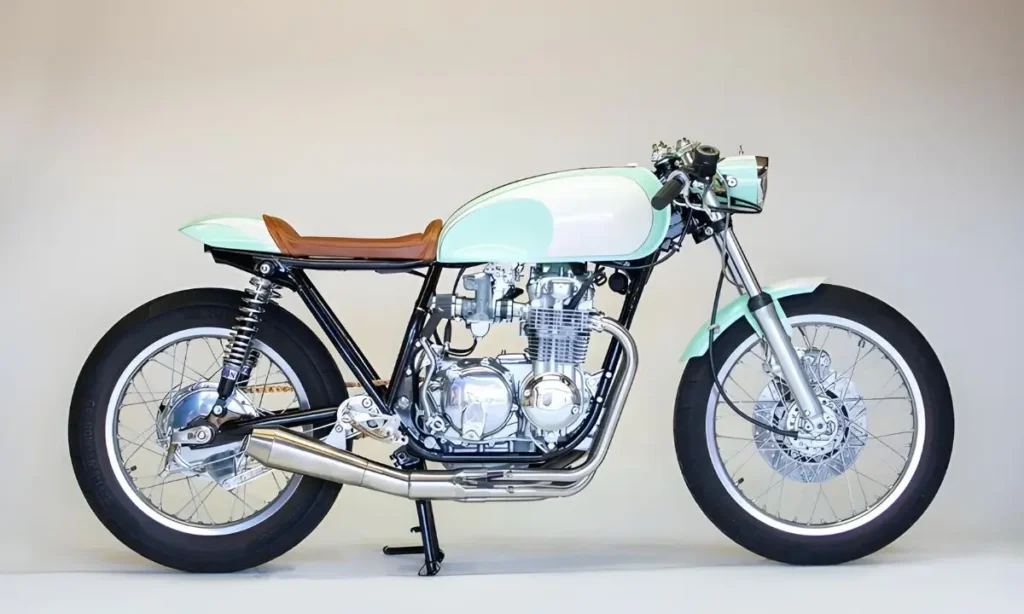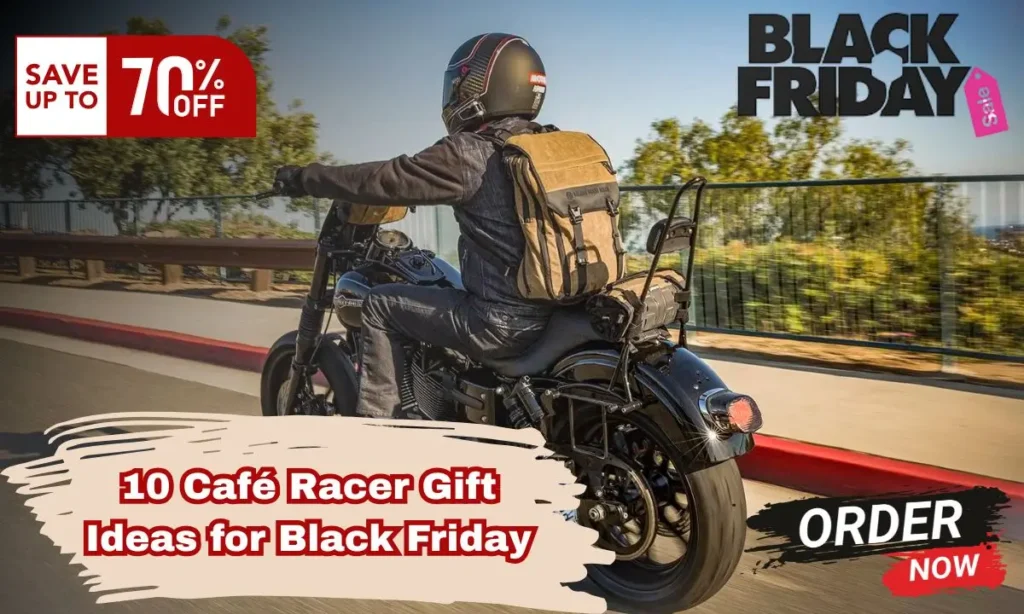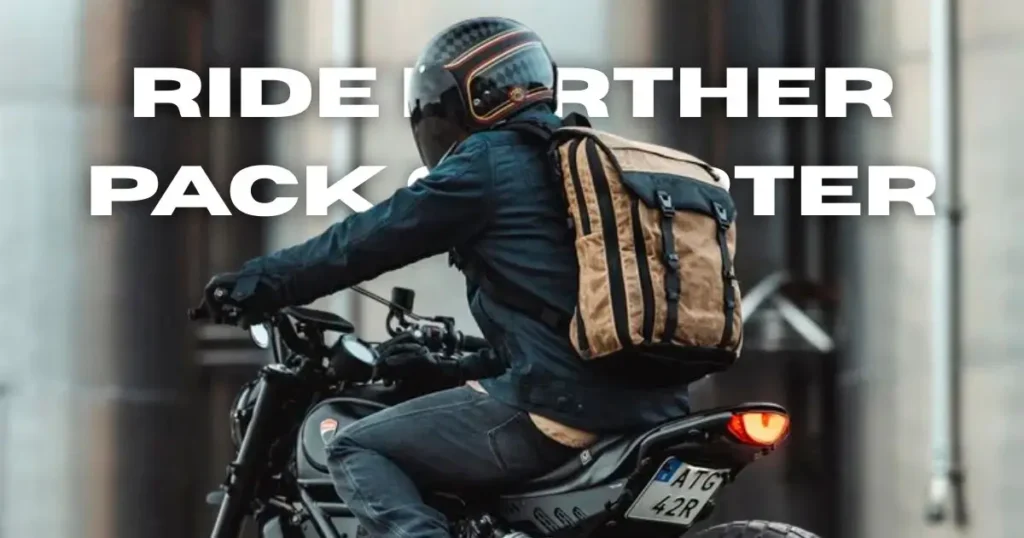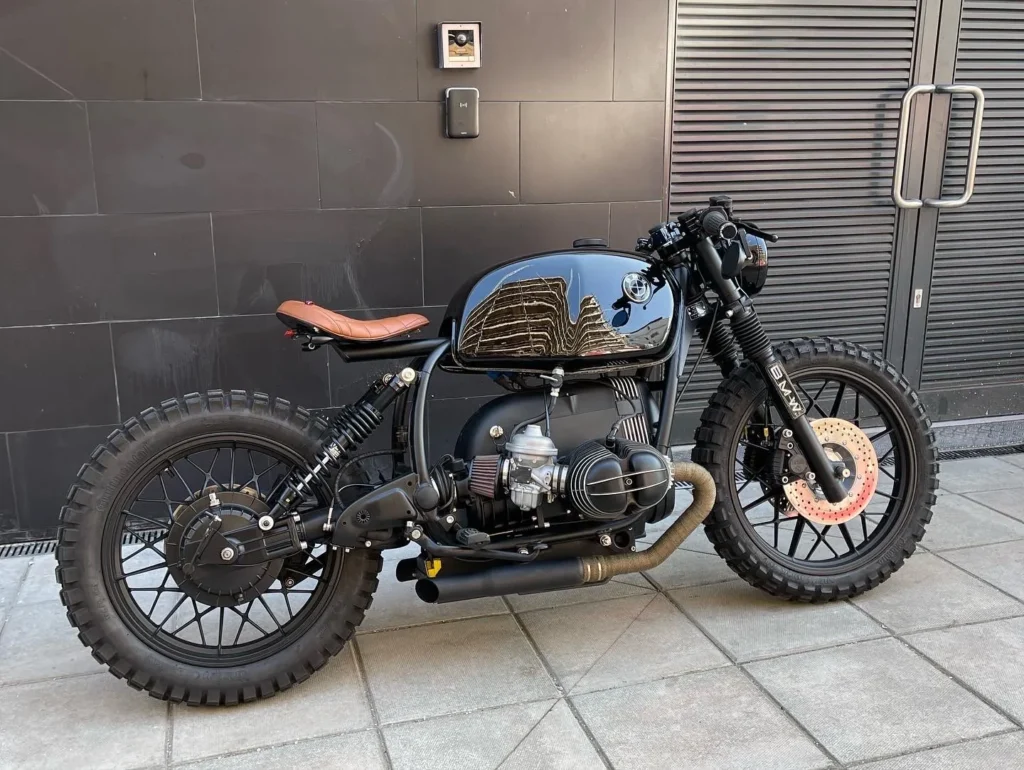Table of Contents
ToggleBuilding a BMW K1100 Café Racer is a fun and rewarding project. In this guide, I will show you each step, from learning what a Café Racer is to picking the BMW K1100 as your base. We will also cover the final touches that make your bike special. Whether you are new to customizing motorcycles or have experience, this guide will help you create your dream bike. You will learn about the history of Café Racers, important changes to make, the tools you need, and how to solve problems. By the end, you will be proud to show off your custom Café Racer. This guide is clear and simple, so anyone can follow it, even if you are just starting. Let’s begin building your BMW K1100 Café Racer.

What is a Café Racer?
A Café Racer is a special kind of motorcycle. It has a cool look and a fun history. It started in the 1960s in England. Young riders wanted their bikes to go faster and look better. They took off parts they didn’t need to make the bikes lighter and quicker. The riders raced from one café to another. That’s how the bikes got the name “Café Racers.”
Café Racers have a simple and sleek design. The seats are low and narrow. The fuel tank is long and flat. The handlebars are low too, so the rider leans forward. This gives the bike a sporty look. The engines are powerful, and the whole design is made to be fast and stylish.
The Origins of Café Racers
Café Racers started in the 1960s in England. Young motorcycle riders, called “rockers,” wanted their bikes to be faster and cooler. They met at cafés, which were popular places to hang out. The riders would race from one café to another. These races were short, and the goal was to reach 100 miles per hour, which they called “the ton.”
To go faster, the riders took off parts they didn’t need to make their bikes lighter. They also made their motorcycles look sleek and sporty. Over time, this style of bike became known as the Café Racer, named after the cafés where the riders gathered.
Café Racers became a symbol of freedom and rebellion. They showed a youthful spirit that loved speed and adventure. This style is still popular today. Many people still build and ride Café Racers.
Characteristics of a Café Racer
Café Racers have a few key features that make them easy to spot. First, they are built to be fast and light. Riders take off any parts they don’t need, like big fenders or large seats. This makes the bike lighter, so it goes faster.
Second, the design of a Café Racer is simple and sleek. The fuel tank is long and narrow, and the seat is small and low. The handlebars are set low, so the rider leans forward. This gives the bike a sporty look and helps with speed.
Third, Café Racers often have a loud, strong engine. The exhaust pipes are changed to make a roaring sound. This adds to the thrill of riding a Café Racer.
Finally, the look of a Café Racer is about style and speed. These bikes are often customized with special paint and parts to match the rider’s personality. In short, Café Racers are fast, stylish, and perfect for riders who love speed and good looks.
Why Choose a Café Racer Style for a BMW K1100?

Choosing a Café Racer style for a BMW K1100 is a good idea for many reasons. First, the BMW K1100 has a strong and reliable engine. This makes it perfect for a fast and powerful Café Racer. The engine is smooth and can handle the demands of a sporty motorcycle.
Second, the BMW K1100 has a solid frame that is easy to modify. You can change the seat, handlebars, and fuel tank to create the low, sleek look that Café Racers are known for. This makes it simple to turn the bike into a classic Café Racer.
Third, the BMW K1100 is a well-built and durable motorcycle. Even after you make changes to turn it into a Café Racer, it will still be a dependable bike. You can enjoy it for many years.
Why is the BMW K1100 Ideal for a Café Racer Build?
The BMW K1100 is a great choice for building a Café Racer because of its strong engine, rich history, and flexible design.
History and Evolution of the BMW K1100
The BMW K1100 came out in the early 1990s. It is part of BMW’s “K-series” of motorcycles. This bike was known for its advanced technology and solid engineering. The K1100 is both powerful and comfortable. Many people liked it for long rides. Over time, it has become a favorite among motorcycle fans. They like it because it is reliable and strong. This history of good performance makes the K1100 a great choice for building a Café Racer.
Engine Performance and Specifications
The BMW K1100 is powered by a strong and smooth inline-four engine, which makes it perfect for a Café Racer. Here are some key specifications:
- Engine Type: 1,092cc, liquid-cooled, inline-four engine
- Horsepower: Approximately 100 hp @ 7,500 rpm
- Torque: 79 lb-ft @ 5,500 rpm
- Fuel System: Electronic fuel injection
- Transmission: 5-speed gearbox
- Final Drive: Shaft drive
- Front Suspension: Telescopic forks with anti-dive system
- Rear Suspension: Monoshock with adjustable preload
- Front Brakes: Dual 305mm discs with 4-piston calipers
- Rear Brakes: Single 285mm disc with 2-piston caliper
- Weight: Approximately 590 lbs (267 kg) wet
- Fuel Capacity: 22 liters (5.8 gallons)
- Top Speed: Around 130 mph (210 km/h)
- Seat Height: 31.5 inches (800 mm)
These specifications provide the K1100 with the speed and power needed for a Café Racer, while also offering reliability and smooth performance.
Frame and Body Design Advantages
The BMW K1100’s frame and body design make it easy to customize into a Café Racer. Some advantages include:
- Sturdy Frame: The K1100 has a strong frame that can support modifications, such as lowering the seat or changing the fuel tank.
- Single-Sided Swingarm: This feature allows for easier wheel changes and adds a unique look to the bike.
- Low Center of Gravity: The bike’s design keeps the weight low, improving handling and stability.
These design features make the K1100 a flexible and reliable base for creating a stylish and functional Café Racer.
Comparing the BMW K1100 to Other Café Racer Bases
When you compare the BMW K1100 to other Café Racer bikes, it stands out. It has a strong engine and solid build. Other bikes might be lighter or more common for Café Racers. But the K1100 gives you a mix of power, reliability, and easy customization. This makes it a great pick for those who want a Café Racer that is unique and dependable.
How to Start a BMW K1100 Café Racer Project?
Starting a BMW K1100 Café Racer project is exciting. But it needs careful planning. Here’s a simple guide to help you begin.
Setting a Budget for Your Build
Before you start, set a budget. This helps you plan and avoid surprises. Here are some budget ideas:
- Base Motorcycle: $2,500 – $5,000 (depends on condition and location)
- Basic Tools and Equipment: $500 – $1,000
- Custom Parts (seat, handlebars, etc.): $1,000 – $3,000
- Engine Upgrades: $1,000 – $2,500
- Paint and Finishing: $500 – $1,500
- Miscellaneous Costs (labor, unexpected issues): $1,000 – $2,000
- Total Estimated Budget: $6,500 – $15,000
Your budget may change based on where you are, the bike’s condition, and how much you customize.
Finding a Suitable BMW K1100 for Your Project
Next, find the right BMW K1100. Look for a bike in good mechanical shape. This saves time and money on repairs. You can search online, at dealerships, or in motorcycle clubs. Check the bike’s history, mileage, and any past modifications. A well-kept bike with a clean title is a good start.
Legal Considerations and Registration
Before modifying your bike, know the legal rules. Make sure your changes follow local laws, like noise limits, lighting rules, and emissions standards. Check if your changes could affect the bike’s registration. In some cases, you may need an inspection after making changes. It’s wise to talk to your local DMV or a legal expert on motorcycle laws.
Planning the Build: Timeline and Phases
Plan your build by setting a timeline and breaking it into steps. This keeps you organized. Here’s a simple timeline:
- Phase 1: Disassembly (1-2 weeks)
Take the bike apart. Remove unneeded parts and label everything for reassembly. - Phase 2: Frame and Body Modifications (2-4 weeks)
Modify the frame, install new parts, and make structural changes. - Phase 3: Engine and Performance Upgrades (2-3 weeks)
Upgrade the engine, suspension, and brakes. - Phase 4: Electrical Work (1-2 weeks)
Simplify the wiring, install new electronics, and test everything. - Phase 5: Paint and Finishing (1-2 weeks)
Prep the bike for painting, apply the paint, and add custom touches. - Phase 6: Reassembly and Testing (2-3 weeks)
Put the bike back together, do final checks, and test it to make sure it works.
By planning ahead and breaking the project into steps, you can manage your time well and keep your build on track.
What Tools and Equipment are Needed?
Building a BMW K1100 Café Racer needs the right tools and equipment. This guide will help you know what to use.
Essential Tools for Disassembly and Assembly
To start, you’ll need basic tools to take the bike apart and put it back together:
- Socket Set and Wrenches: For loosening and tightening bolts and nuts.
- Screwdrivers: Both flathead and Phillips, for removing screws.
- Pliers and Wire Cutters: For gripping parts and cutting wires.
- Allen Wrenches: For working with hex bolts, common on motorcycles.
- Torque Wrench: To make sure bolts are tightened correctly.
- Impact Driver: Helpful for loosening tough bolts.
These tools will help you take apart the motorcycle and then put it back together after making changes.
Advanced Fabrication Tools
If you plan to make big changes, you’ll need advanced tools:
- Angle Grinder: For cutting and shaping metal parts.
- Welding Machine: Needed if you want to change or make parts of the frame.
- Drill Press: For drilling holes precisely when adding new parts.
- Pipe Bender: For custom exhaust pipes or handlebars.
- Bench Grinder: To smooth rough edges and sharpen tools.
These tools are important if you want a high level of customization for your Café Racer.
Sourcing Specialized Equipment and Parts
Getting the right parts is key to making a unique and working Café Racer. Here’s where to find them:
- Online Retailers: Websites like eBay and Amazon, or specialty motorcycle shops.
- Local Motorcycle Shops: They may have parts in stock or can order them for you.
- Motorcycle Swap Meets: Good places to find rare and old parts.
- Custom Fabricators: If you need a part that you can’t find, a fabricator can make it for you.
Taking the time to find the right parts will help your build meet your style and performance goals.
Safety Gear and Workshop Setup
Safety is important when working on a motorcycle. Make sure your workshop has:
- Safety Glasses: To protect your eyes from debris when cutting or grinding.
- Gloves: To protect your hands from sharp edges, hot parts, and chemicals.
- Ear Protection: Important when using loud tools like grinders or impact drivers.
- Fire Extinguisher: Always have one nearby, especially if you’re welding or working with flammable materials.
- Good Lighting: Make sure your workshop is well-lit so you can see clearly.
- Ventilation: Proper airflow is key when working with fumes or dust.
Setting up your workshop with the right safety gear and equipment will help you work safely and avoid accidents.
By having the essential tools, advanced equipment, finding the right parts, and ensuring safety, you’ll be ready to start your BMW K1100 Café Racer build.
How to Strip Down the BMW K1100?
Stripping down a BMW K1100 is the first big step to turning it into a Café Racer. This means carefully removing parts so you can customize the bike later. Here’s how to do it.
Removing the Fairings and Bodywork
First, take off the fairings and bodywork. The BMW K1100 has large, protective fairings that you won’t need for a Café Racer. Start by:
- Unscrewing Bolts and Fasteners: Use a screwdriver or wrench to remove the screws and bolts holding the fairings.
- Gently Removing Panels: Once all fasteners are out, gently pull off the panels. Be careful not to break any clips or tabs.
- Removing the Seat: The seat is held by a few bolts underneath. Unscrew them and lift the seat off.
For an in-depth guide on choosing the perfect seat, check out our detailed article here.
After this, you’ll have a clear view of the bike’s frame and parts, making it easier to plan your changes.
Disassembling the Engine and Transmission
Next, take apart the engine and transmission. These are key to your Café Racer build. Here’s how to do it:
- Drain Fluids: Before starting, drain the oil, coolant, and other fluids to avoid spills.
- Disconnect Cables and Wires: Carefully unplug any cables connected to the engine and transmission. Label them if needed to remember where they go.
- Remove the Exhaust System: Unbolt the exhaust pipes from the engine and set them aside.
- Detach the Engine from the Frame: The engine is bolted to the frame. Support the engine with a jack, then remove the bolts and carefully lower the engine out of the frame.
This step lets you upgrade the engine, making your Café Racer more powerful and reliable.
Handling the Electrical System
The electrical system of the BMW K1100 can be tricky, so handle it with care:
- Disconnect the Battery: Start by disconnecting the battery to prevent shocks or short circuits.
- Label Wires: As you unplug wires, label them to keep track of what goes where. This will help during reassembly.
- Remove the Wiring Harness: Carefully remove the wiring harness from the frame. You may need to change or replace it later for a cleaner look.
Handling the electrical system correctly ensures your Café Racer will run smoothly when reassembled.
Cataloging and Storing Parts for Reassembly
As you take the bike apart, keep track of all the parts:
- Label and Bag Small Parts: Use ziplock bags for small parts like screws, nuts, and bolts. Label each bag to remember where they go.
- Organize Larger Parts: Place larger parts, like the engine and fairings, on shelves or in bins. Keep them organized so you can easily find them later.
- Take Photos: Take pictures of how parts are assembled before taking them apart. These photos will help during reassembly.
By carefully organizing and storing parts, you’ll make the reassembly process easier and avoid losing anything.
Stripping down the BMW K1100 is a crucial step in your Café Racer project. By removing the fairings and bodywork, taking apart the engine and transmission, handling the electrical system carefully, and organizing parts for reassembly, you’ll be ready to start customizing your bike.
What Are the Key Modifications for a Café Racer?
Transforming a BMW K1100 into a Café Racer requires several key changes to give the bike its unique look and better performance. Here’s what you need to do.
Customizing the Frame and Subframe
Start by customizing the frame and subframe. This is important for getting the classic Café Racer shape:
- Shorten the Subframe: Many Café Racers have a shorter subframe for a compact look. You do this by cutting the current subframe and welding on a shorter one.
- Strengthen the Frame: If you plan to add more weight or stress to the bike, make the frame stronger to keep it safe.
- Add a Seat Loop: Adding a seat loop at the end of the subframe supports the new seat and looks good too.
These changes give your bike the classic Café Racer profile and keep it strong.
Improving the Suspension
Improving the suspension is key for both performance and style:
- Lower the Suspension: Café Racers often have a lower stance. You can lower the bike by adjusting or replacing the front forks and rear shocks.
- Upgrade the Shocks: Install better shocks for smoother rides and better handling.
- Adjust the Forks: You might want to swap the front forks for more modern ones to improve both the look and feel.
These suspension changes will make your bike handle better and give it a lower, sportier stance.
Upgrading the Engine
Boosting the engine’s performance is essential:
- Tune the Engine: Start with a full tune-up. Replace spark plugs, filters, and fluids to keep the engine running well.
- Upgrade Carburetors or Fuel Injection: Depending on your setup, you can upgrade the carburetors for better airflow or improve the fuel injection for more power.
- Add Performance Parts: Consider adding a high-flow air filter, custom exhaust, or upgraded camshafts for more power and quicker response.
These upgrades will make your Café Racer faster and more fun to ride.
Customizing the Fuel Tank and Seat
The fuel tank and seat are central to the Café Racer’s look and comfort:
- Replace or Modify the Fuel Tank: Many builders choose a narrower tank for a sleeker look. You can modify the original tank or replace it with a custom one.
- Install a Café Racer Seat: The seat is usually a solo, flat seat that sits low on the frame. You can buy a ready-made Café Racer seat or customize one to fit your design.
- Align the Tank and Seat: Make sure the lines of the fuel tank and seat flow together smoothly. This is key to the bike’s overall look.
Customizing the tank and seat will not only improve how your bike looks but also make it more comfortable to ride.
Choosing and Installing the Exhaust System
The exhaust system is both functional and stylish for a Café Racer:
- Choose a Custom Exhaust: Many Café Racers have shorter, louder exhausts. Popular choices include megaphone-style exhausts or short reverse cone mufflers.
- Install High-Quality Headers: Upgrading the headers improves exhaust flow, boosting engine performance.
- Position the Exhaust: Café Racers often have the exhaust positioned higher for a sportier look. Ensure the exhaust is securely mounted and doesn’t interfere with other parts.
A custom exhaust will boost your bike’s performance and give it the classic Café Racer look and sound. If you ride a BMW K1100, check out our article on the Best Modifications for BMW K1100 Cafe Racer. You’ll find easy tips on choosing the right exhaust and other upgrades to make your bike perfect.
How to Approach the Electrical System?
Working on the electrical system of your BMW K1100 Café Racer means simplifying and upgrading parts for a cleaner look and modern features. Here’s how to do it.
Simplifying the Wiring Harness
Start by simplifying the wiring harness. The original wiring on the BMW K1100 is complex and bulky. Simplifying it will create a cleaner look:
- Remove Unnecessary Wires: Identify and remove any wires that you don’t need, like those for stock lights or unused accessories.
- Re-route the Remaining Wires: Neatly tuck the remaining wires along the frame and secure them with zip ties or clips. This improves the bike’s appearance and protects the wires.
Simplifying the wiring harness makes the bike’s electrical system easier to manage and gives it a neater, more minimalist look.
Upgrading to Modern Electronics and Gauges
Upgrading the electronics and gauges adds style and function to your Café Racer:
- Install a Modern Speedometer and Tachometer: Replace the old gauges with smaller, modern ones that match the Café Racer style. Digital or simple analog gauges are popular choices.
- Add Electronic Ignition: Upgrade to an electronic ignition system for more reliable starts and smoother performance.
- Modern Switchgear: Replace the handlebar switches with smaller, modern ones to keep a clean, sleek look.
These upgrades improve the bike’s performance and give it a more modern feel.
Installing LED Lighting and Indicators
LED lighting is a great way to modernize your Café Racer while improving safety:
- LED Headlight: Replace the stock headlight with a brighter, energy-saving LED headlight. Many Café Racers use round LED headlights to keep the classic look.
- LED Indicators: Install small, sleek LED turn signals that are less bulky than the originals. They are more visible and use less power.
- LED Tail Light: A compact LED tail light can enhance the rear look and provide better visibility to other drivers.
LED lighting not only looks great but also reduces the electrical load on your bike.
Battery Relocation and Charging System Upgrades
Moving the battery and upgrading the charging system are important for both looks and performance:
- Battery Relocation: Move the battery to a hidden spot, like under the seat or in a custom box. This cleans up the bike’s lines and adds to the minimalist style.
- Install a Lithium-Ion Battery: Upgrade to a smaller, lighter lithium-ion battery. These batteries are compact and provide reliable power.
- Upgrade the Charging System: If you’ve added modern electronics, it’s wise to upgrade the charging system. This might include a more powerful alternator or a modern voltage regulator to keep your battery charged.
By upgrading the electrical system—simplifying the wiring, adding modern electronics, installing LED lighting, and relocating the battery—you’ll improve both the function and look of your BMW K1100 Café Racer.
What Are the Best Tires and Wheels for a BMW K1100 Café Racer?
Choosing the right tires and wheels for your BMW K1100 Café Racer is key for both performance and style. Here’s how to make the best choices.
Choosing the Right Tire Size and Type
The tires you pick will greatly affect how your Café Racer rides and looks:
- Tire Size: Café Racers usually have wider rear tires and slightly narrower front tires. For the BMW K1100, a common choice is a 120/70-17 tire for the front and a 160/60-17 for the rear. This setup gives good grip and stability.
- Tire Type: Consider tires that offer both style and performance. Classic tread patterns give a vintage look, while modern compounds offer better grip and durability. Dual-sport tires are also popular, balancing road handling with a rugged look.
Selecting the right tire size and type will boost your bike’s performance and fit its Café Racer style.
Wheel Options: Spoke vs. Alloy
For wheels, you have two main choices: spoke wheels and alloy wheels. Each has its benefits:
- Spoke Wheels: Spoke wheels give your Café Racer a classic, vintage look. They are also more flexible, which can help absorb shocks on rough roads. However, they need more care, as the spokes must be checked and tightened regularly.
- Alloy Wheels: Alloy wheels are modern, light, and need less maintenance. They also offer better handling and resist damage. While they may not have the vintage charm of spoke wheels, they can still look great on a Café Racer with the right design.
Read More: [Spoke Wheels Vs Alloy Wheels – Which is Better For Cafe Racer?]
Balancing Aesthetics and Performance
When picking tires and wheels, it’s important to balance looks with performance:
- Aesthetics: Think about the overall look you want for your Café Racer. Spoke wheels and classic tire treads enhance the vintage appeal, while alloy wheels and modern tires give a sleeker, more contemporary look.
- Performance: Don’t sacrifice performance for style. Make sure the tires you choose provide good traction and handling, especially if you plan to ride the bike often. Alloy wheels may offer better performance, but spoke wheels can give a smoother ride on rough roads.
Finding the right balance between how your bike looks and how it performs will ensure you enjoy both the style and the ride.
Installation and Alignment
Proper installation and alignment are critical to getting the most from your new tires and wheels:
- Installation: It’s best to have your tires and wheels installed by a professional to ensure they are mounted correctly. Improper installation can lead to handling issues and uneven tire wear.
- Alignment: After installing new wheels and tires, check the alignment. Proper alignment ensures that the bike handles well and that the tires wear evenly. This will also help prevent strain on the suspension.
By carefully choosing the right tires and wheels, balancing looks with performance, and ensuring proper installation and alignment, you’ll improve both the look and feel of your BMW K1100 Café Racer.
How to Customize the Paint and Finish?
Customizing the paint and finish of your BMW K1100 Café Racer is a key step in making the bike truly yours. Here’s how to do it.
Selecting a Color Scheme for Your Café Racer
The colors you choose will define the look and feel of your Café Racer:
- Match Your Style: Pick colors that reflect your style or the classic Café Racer look. Popular choices are matte black, deep blues, and metallic finishes. Bright colors can also make your bike stand out.
- Contrast and Accents: Use contrasting colors for accents like stripes, logos, or details on the fuel tank and seat. This adds depth and interest to the design.
- Timeless Appeal: Think about how the color will age. Classic color schemes often stay stylish for years.
Choosing the right color scheme gives your bike a cohesive and well-designed look.
Surface Preparation: Sanding and Priming
Proper surface prep is essential for a smooth and lasting finish:
- Sanding: Start by sanding the surfaces you plan to paint, like the fuel tank, frame, and bodywork. Use fine-grit sandpaper to create a smooth surface. This helps the paint stick better and creates a polished finish.
- Priming: After sanding, apply a primer. Primer provides a good base for the paint and helps prevent rust. It also makes the final color even and vibrant.
Taking time to sand and prime your bike will result in a better and longer-lasting paint job.
Painting Techniques and Finishes
Using the right painting techniques and finishes is crucial:
- Spray Painting: Spray painting is the most common way to paint motorcycles. It allows for even coverage and a professional finish. Apply several thin coats, letting each coat dry before adding the next.
- Custom Finishes: Choose from finishes like matte, gloss, or metallic. Matte finishes give a subtle, modern look, while gloss finishes offer a shiny appearance. Metallic paints add a unique shimmer.
- Layering: Consider layering different finishes for added depth. For example, a base coat of metallic paint with a clear gloss topcoat can create a striking effect.
Using the right techniques and finishes will make your bike look great and stay protected.
Applying Decals and Protective Coatings
The final steps in customizing your paint job involve adding decals and protective coatings:
- Decals: If you want to add logos, stripes, or custom designs, apply decals after the paint is fully dry. Decals are a simple way to personalize your bike and add details without complex painting.
- Protective Coatings: Once the decals are in place, apply a clear protective coating over the painted surface. This protects the paint from scratches, UV damage, and weathering. A good clear coat will also enhance the finish, giving it a glossy, professional look.
By following these steps, you’ll create a paint job that looks stunning and lasts for years, keeping your BMW K1100 Café Racer in top condition.
What Are the Best Practices for Reassembly?
Reassembling your BMW K1100 Café Racer is an exciting step. This is where all your hard work comes together. Following best practices will make sure your bike runs smoothly and looks great.
Reinstalling the Engine and Transmission
Start by carefully putting the engine and transmission back in place:
- Secure the Engine: Position the engine back into the frame. Secure it with the right bolts. Make sure everything is aligned and tighten the bolts to the manufacturer’s specs.
- Connect the Transmission: Reattach the transmission to the engine. Make sure all connections are tight and aligned. Check that the gears shift smoothly.
Taking your time here ensures that your bike will work well and avoid any mechanical problems.
Wiring the Electrical System
Next, focus on wiring the electrical system. This is key to the bike’s operation:
- Reconnect the Wiring Harness: Start by reconnecting the wiring harness to the engine and other parts. Follow the labels you made during disassembly to ensure everything is connected right.
- Check for Proper Connections: Make sure all connections are secure and free from rust. This will help prevent electrical issues later.
- Test the Electrical System: Before moving on, test the electrical system to make sure everything is working. Check the lights, gauges, and ignition.
Proper wiring will help avoid future problems and ensure your bike is safe to ride.
Installing the Custom Seat and Bodywork
After the electrical system is sorted, install the custom seat and bodywork:
- Attach the Seat: Position the custom seat on the modified subframe. Secure it with bolts. Make sure it’s firmly in place and aligned with the bike’s design.
- Install Body Panels: Reattach any body panels like the fuel tank, side covers, and custom pieces. Make sure everything fits well and is securely fastened.
Installing the seat and bodywork gives your Café Racer its final shape and style.
Final Checks and Adjustments
Before riding, do final checks and adjustments to ensure everything works:
- Check All Bolts and Fasteners: Go over the entire bike. Tighten all bolts and fasteners to make sure nothing is loose.
- Test the Brakes and Suspension: Press the brakes and bounce the suspension to make sure they work properly.
- Inspect the Tires and Wheels: Make sure the tires are properly inflated and the wheels are aligned. This is important for safe handling.
By following these steps, you’ll ensure that your BMW K1100 Café Racer is ready to ride and safe for your adventures.
How to Tune and Test Your Café Racer?
Once your BMW K1100 Café Racer is fully assembled, the next step is to tune and test it. This ensures it runs smoothly and safely. Proper tuning and testing are key for good performance and a great riding experience.
Initial Start-Up Procedures
The first step is the initial start-up, where you bring your Café Racer to life:
- Check Fluids: Before starting the engine, make sure all fluids—oil, coolant, and brake fluid—are at the correct levels.
- Inspect Connections: Double-check that all electrical connections, fuel lines, and cables are secure.
- First Start: Turn the key and start the engine. Listen for unusual noises and watch for leaks or warning lights. Let the engine idle for a few minutes to warm up and check that everything works.
Starting the bike for the first time is exciting, but stay focused and watch for any issues.
Carburetor and Fuel Injection Tuning
Tuning the fuel system is important for making the engine run well:
- Carburetor Tuning: If your bike has a carburetor, adjust the air-fuel mixture and idle speed. This may involve tweaking the jets and screws until the engine responds well to throttle input.
- Fuel Injection Tuning: For fuel-injected models, you may need a tuning device or software to adjust the fuel map. This ensures the fuel injection system delivers the right amount of fuel at all RPMs.
- Test Throttle Response: After tuning, test the throttle response at different speeds to make sure the engine runs smoothly.
Proper tuning of the fuel system ensures your bike performs well under all riding conditions.
Suspension and Brake Adjustments
Adjusting the suspension and brakes is key to safe and comfortable riding:
- Suspension Tuning: Adjust the front forks and rear shocks to suit your riding style. This might involve changing the preload, compression, and rebound settings.
- Brake Adjustment: Check the brake pads, rotors, and fluid levels. Adjust the brake lever and pedal to ensure they work smoothly and provide strong stopping power.
- Test Ride: After making adjustments, take the bike for a short ride to test the suspension and brakes. Make further adjustments as needed.
Making sure the suspension and brakes are set up correctly will give you confidence and control while riding.
Road Testing and Performance Tweaks
The final step is road testing, where you fine-tune your Café Racer’s performance:
- Short Test Rides: Begin with short test rides around your neighborhood or a quiet road. Pay attention to how the bike handles, accelerates, and stops.
- Check for Issues: During the test rides, listen for unusual noises and feel for any vibrations or handling problems. If you notice any issues, address them right away.
- Performance Tweaks: Based on your test rides, make any necessary tweaks to the engine, suspension, or brakes. This might include further tuning the carburetor, adjusting the suspension, or fine-tuning the brakes.
Road testing lets you make sure your Café Racer is running at its best and gives you a chance to enjoy your work.
By carefully tuning and testing your BMW K1100 Café Racer, you’ll make sure it looks great and performs safely on the road.
What Are Common Challenges and Solutions?
Building a BMW K1100 Café Racer is rewarding, but it has challenges. Knowing how to handle these issues will help you finish your build successfully. Here’s how to address some common problems you might face.
Troubleshooting Engine Issues
Engine problems can be frustrating, but you can often solve them with careful checks:
- Starting Problems: If the engine won’t start, check the battery, fuel supply, and ignition system. Make sure the spark plugs are clean and properly gapped.
- Overheating: If the engine overheats, check the coolant level and radiator for blockages. Make sure the cooling fan works properly.
- Poor Performance: If the engine runs rough or lacks power, inspect the carburetor or fuel injection system for proper tuning. Also, check the air filter and exhaust for any blockages.
Fixing these engine issues early will keep your Café Racer running smoothly.
Dealing with Electrical Problems
Electrical problems are another common issue, especially with older bikes:
- Dead Battery: If the battery keeps dying, check the charging system, including the alternator and voltage regulator. Make sure all electrical connections are clean and secure.
- Faulty Wiring: If lights flicker or you lose power, inspect the wiring harness for loose or frayed wires. Simplifying the wiring can also reduce potential problems.
- Blown Fuses: If fuses keep blowing, there may be a short circuit. Carefully trace the wiring to find the source of the problem.
Dealing with electrical problems takes patience, but with careful work, you can fix them and keep your bike reliable.
Overcoming Fabrication Difficulties
Fabrication challenges are common when customizing parts for a Café Racer:
- Frame Modifications: Cutting and welding the frame can be tricky. Measure everything carefully and use the right tools. If you’re not confident in your welding skills, consider hiring a professional.
- Custom Parts Fitment: Sometimes custom parts don’t fit as expected. Be ready to make small adjustments, like grinding or reshaping parts, to get a perfect fit.
- Maintaining Structural Integrity: When modifying the frame or subframe, make sure the bike stays strong. Always reinforce areas that have been cut or altered.
Overcoming these fabrication issues takes precision and sometimes outside help, but it’s essential for creating a safe and stylish Café Racer.
Legal and Registration Challenges
Legal and registration issues can come up after making big changes to your bike:
- Compliance with Regulations: Make sure your modifications follow local laws, like noise limits, lighting requirements, and emissions standards. Not following the rules can lead to fines or problems registering your bike.
- Registration Process: After finishing your build, you may need to have your bike inspected to meet safety standards. Be ready for possible delays, especially if your modifications are extensive.
Navigating these legal challenges is important to ensure your Café Racer is road-legal and properly registered. For more information on insuring your custom Café Racer, check out my other blog about Café Racer insurance, where I discuss what you need to know to protect your investment.
How to Maintain Your BMW K1100 Café Racer?
Maintaining your BMW K1100 Café Racer is key to keeping it in top shape and ensuring it runs smoothly for years. Here’s how to take care of your bike with regular maintenance and proper care.
Regular Maintenance Schedule
Following a regular maintenance schedule is essential for your Café Racer’s longevity and performance:
- Oil Changes: Change the engine oil and filter every 3,000 to 5,000 miles or once a year. Fresh oil keeps the engine running smoothly and prevents wear.
- Check the Tires: Regularly inspect the tires for wear and ensure they are properly inflated. Replace them when the tread is low or if you see any cracks.
- Brake Inspection: Check the brake pads, rotors, and fluid levels regularly. Replace the pads if they are worn and make sure the brakes work properly.
- Chain and Sprockets: Lubricate the chain regularly and check the sprockets for wear. Replace them if they show signs of damage.
Sticking to a maintenance schedule helps prevent problems and keeps your bike performing at its best.
Seasonal Storage Tips
If you need to store your Café Racer during the off-season, proper storage is important to avoid damage:
- Clean the Bike: Before storing, thoroughly clean your bike to remove dirt and grime that could cause corrosion.
- Stabilize the Fuel: Add a fuel stabilizer to the tank to keep the fuel fresh. Run the engine for a few minutes to circulate the stabilizer.
- Battery Care: Disconnect the battery and store it in a cool, dry place. Use a battery tender to keep it charged during storage.
- Cover the Bike: Use a breathable motorcycle cover to protect your bike from dust and moisture.
Following these tips will help ensure your bike is ready to ride when the season starts again.
Cleaning and Protecting the Finish
Keeping your Café Racer clean and protecting its finish is essential for maintaining its appearance:
- Regular Washing: Wash your bike regularly with mild soap and water to remove dirt and debris. Avoid harsh chemicals that could damage the paint or chrome.
- Waxing: Apply quality wax to the painted surfaces to protect them from UV rays and road grime. This also keeps your bike looking shiny and new.
- Protecting Chrome and Metal Parts: Use a chrome polish to clean and protect metal parts. This helps prevent rust and corrosion.
By regularly cleaning and protecting the finish, you’ll keep your Café Racer looking its best for years to come.
Finding Replacement Parts and Accessories
Over time, you may need to replace parts or add new accessories to your Café Racer:
- OEM Parts: For original parts, check with BMW dealerships or specialized online retailers. Using OEM parts ensures a perfect fit and maintains the bike’s integrity.
- Aftermarket Parts: If you’re looking for custom parts, many aftermarket suppliers offer high-quality options that can enhance your bike’s performance and style.
- Motorcycle Forums and Clubs: Joining forums or clubs dedicated to Café Racers or BMW motorcycles is a great way to find parts, accessories, and advice from other enthusiasts.
Finding the right parts and accessories helps you keep your Café Racer in top shape and allows you to personalize it to your liking.
By following these maintenance tips, storing your bike properly, cleaning it regularly, and knowing where to find replacement parts, you’ll ensure that your BMW K1100 Café Racer stays in excellent condition and continues to perform beautifully on the road.
What Are the Costs Involved in Building a BMW K1100 Café Racer?
Building a BMW K1100 Café Racer is fun, but it can cost a lot. Knowing what to expect can help you budget well and make smart choices during the build.
Major Costs to Plan For
Building a Café Racer can cost different amounts, but here are the big expenses:
- Base Motorcycle: Buying a BMW K1100 can cost between $2,500 and $5,000. The price depends on the bike’s condition and mileage.
- Parts and Modifications: Custom parts like seats, handlebars, exhausts, and lights can add $1,000 to $3,000. Engine and suspension upgrades can cost more.
- Tools and Equipment: If you don’t have the tools you need, you may spend $500 to $1,000 on basic and special tools.
- Paint and Finish: A professional paint job can cost $500 to $1,500, depending on the design.
- Labor Costs: Hiring professionals for jobs like welding or electrical work can add to the cost.
Overall, building a BMW K1100 Café Racer might cost between $6,500 and $15,000 or more, depending on your choices.
Tips to Save Money
You can save money without losing quality. Here’s how:
- DIY Work: The more you do yourself, the less you spend on labor. Learning basic skills can save a lot.
- Used Parts: Look for used or salvaged parts. They can be much cheaper than new ones.
- Plan and Budget: Make a plan and budget before you start. This helps avoid extra costs and keeps you focused.
- Shop Around: Compare prices from different stores to find the best deals.
These tips can help you stretch your budget and get the most from your money.
Where to Spend and Where to Save
Balancing spending and saving is key:
- Where to Spend: Invest in high-quality parts that affect safety and performance, like brakes, suspension, and tires. Also, a good paint job is worth the extra cost as it makes the bike look great.
- Where to Save: Save money on things that don’t affect the bike’s performance, like some custom parts or accessories. Think about whether the look is worth the extra cost.
Knowing where to spend and where to save makes sure your Café Racer is both safe and stylish without overspending.
Resale Value of a Custom Café Racer
A well-made Café Racer can keep its value or even sell for a good price:
- Unique Appeal: Custom Café Racers are often in demand, especially if they’re well-built with quality parts.
- Condition and Craftsmanship: The better the condition and quality of the build, the higher the resale value. A bike that looks great and runs well will attract more buyers.
- Market Trends: Keep an eye on trends in the Café Racer community. Some styles and modifications may be more popular and valuable at certain times.
Building a Café Racer is a passion project, but it’s good to know your investment could pay off if you decide to sell the bike later.
Final Thoughts
By knowing the costs, using money-saving strategies, balancing your budget, and thinking about resale value, you can manage your BMW K1100 Café Racer build well and enjoy the process without stressing over money.
How to Showcase and Enjoy Your BMW K1100 Café Racer?
After all your hard work, it’s time to enjoy and show off your BMW K1100 Café Racer. Here are some ways to share your bike and have fun with it.
Entering Motorcycle Shows and Competitions
A great way to show off your Café Racer is by entering motorcycle shows and competitions:
- Local and National Shows: Look for motorcycle shows nearby or even bigger events across the country. These shows are perfect places to display your bike and meet other fans.
- Competitions: Entering competitions can be exciting. Judges often look for skill, creativity, and detail, so your Café Racer could win awards.
Participating in shows and competitions not only lets you show off your work but also helps you connect with others who love motorcycles.
Joining Café Racer Clubs and Communities
Joining a Café Racer club or online community is a fun way to enjoy your bike with others:
- Local Clubs: Many cities have Café Racer clubs where members meet to ride, share tips, and talk about their bikes. Joining one is a great way to learn more and make new friends.
- Online Communities: There are also many online forums and social media groups for Café Racers. These are great places to get advice, find inspiration, and hear about events.
Being part of a club or community helps you stay involved and can lead to new friendships and opportunities.
Planning and Enjoying Café Racer Rides
Riding your Café Racer is one of the best ways to enjoy it:
- Group Rides: Join or organize group rides with other Café Racer fans. Riding together on scenic roads can be thrilling.
- Solo Rides: Plan solo rides to explore new places. Riding a Café Racer is all about the journey, so take time to enjoy the ride.
Whether with a group or alone, riding your Café Racer is a rewarding way to enjoy the bike you built.
Sharing Your Build Online: Social Media and Blogs
Sharing your build online is a fun way to connect with others and show off your work:
- Social Media: Platforms like Instagram, Facebook, and Pinterest are perfect for sharing photos and stories about your build. Use popular hashtags to reach more people.
- Blogs and Websites: If you like writing, start a blog or contribute to websites. Sharing your build process can inspire others and show your skills.
By sharing your build online, you can connect with people around the world, inspire others, and even gain recognition.
Final Thoughts
Enjoying and showing off your BMW K1100 Café Racer through shows, clubs, rides, and online sharing celebrates your hard work and deepens your connection to the Café Racer community.
Conclusion
Building a BMW K1100 Café Racer is more than just making a motorcycle. It’s about turning your dream into reality. As you work on your bike, each challenge and success helps you feel closer to it. The long-lasting joy of owning a custom Café Racer comes from knowing it’s truly yours. You made it with your own hands, and it reflects your style and taste.
When you ride your Café Racer, you’ll feel proud and happy. This feeling is special and comes from building something unique. For those who want to build a Café Racer, my advice is to be patient. Learn as much as you can, and enjoy every part of the process.
Remember, building a Café Racer is about the journey, not just the end result. So, take your time, stay focused, and most importantly, have fun along the way.
FAQs
What Makes the BMW K1100 a Good Base for a Café Racer Build?
The BMW K1100 is a great choice for building a Café Racer. It has a strong engine, a solid frame, and is easy to customize.
How Much Does It Typically Cost to Build a BMW K1100 Café Racer?
Building a BMW K1100 Café Racer can cost between $6,500 and $15,000. The cost depends on the parts, tools, and help you need.
What Tools Do I Need to Start Building a BMW K1100 Café Racer?
You’ll need basic tools like a socket set, wrenches, screwdrivers, and pliers. You may also need advanced tools like an angle grinder and a welder.
How Do I Simplify the Electrical System on a BMW K1100 for a Café Racer Conversion?
To simplify the wiring, remove extra wires, upgrade to modern electronics, and move the battery to a new spot. This will make the bike look cleaner.
What Are the Key Modifications Needed to Transform a BMW K1100 Into a Café Racer?
Key changes include customizing the frame, upgrading the suspension, tuning the engine, and adding a new seat, fuel tank, and exhaust system.

